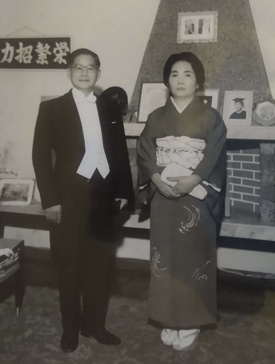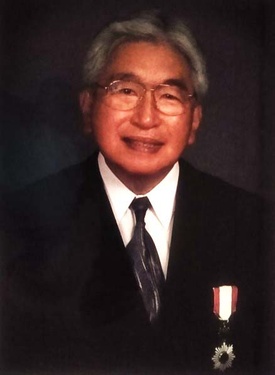Augusto Ikemiyashiro does not seem like a man of this era. Their vocation for service and their strong group spirit are dissenting in these utilitarian and individualistic times.
Don Augusto has been president of some of the most important institutions of the Nikkei community in Peru: Peruvian Japanese Association (APJ), La Unión Stadium Association (AELU) and Okinawan Association of Peru (AOP).
Beyond the status that positions provide, leading these organizations means cutting back on time with family and relegating one's career or business to dedicate oneself to them without receiving a cent in return.
It is not a sacrifice, but a service to the Nikkei community (and by extension to Peru). A moral commitment that he inherited from his father Hidenaga, a Japanese immigrant from Okinawa.
“MY BONES ARE GOING TO STAY HERE”
His father arrived in Peru through yobiyose . He worked in several businesses owned by his compatriots, until he became independent and settled in the hardware business.
A powerful memory from Don Augusto's childhood has his father as the central actor, listening to a radio, listening to news from Japan and writing everything down in a notebook.
His countrymen would then go to his house to be informed. That precious notebook was his newspaper.
Until “the fatal moment” arrived when Japan's surrender was announced. His father was devastated. Don Augusto remembers the sadness with which he told him the news, which probably hurt more than the defeat, because it meant a definitive farewell to his country.
On the verge of crying, he told his son: “My bones are going to stay here.”
THE ODYSSEY OF THE ONIISAN
There was no time for tears. Now that the Ikemiyashiro were going to put down roots in Peru, they had a mission ahead of them: to bring the son they had left in Okinawa, Augusto's older brother.
It was almost a movie. The Peruvian government did not accept the entry of Japanese and the Ikemiyashiro had to entrust themselves to heterodoxy.
Augusto's oniisan took a plane in Japan that landed at Limatambo Airport, on Peruvian land. But his destination was not Peru, but Bolivia. The flight had made a stopover in Lima.
Still, the Ikemiyashiros went to the airport to see their son and brother, far away but visible, standing on the steps. It was a fleeting greeting, a reunion more virtual than real.
A Nikkei family welcomed the oniisan in Bolivia. Meanwhile, Hidenaga began to prepare the entry of his first-born son to Peru with the mediation of a countryman named Gushiken, a friend of high-ranking Peruvian soldiers.
Thanks to his contacts, an identity document was made that made the oniisan a Peruvian citizen. In parallel, after several months of stay in Bolivia, Augusto's brother began his trip to Peru... walking.
To avoid being detected by the police, he walked at night, following the line of electrical cables. This is how he arrived in Peru, where he began a new life with the document managed by Gushiken.
The family joked with him that he had entered Peru “smuggled.”
The case of oniisan was not exceptional. He made his journey on foot in the company of young people, also children of Japanese immigrants, who entered Peru via Bolivia.
The Ikemiyashiro house was the meeting point for the Issei, who planned and coordinated clandestine operations to take their children from Japan to Peru.
Don Augusto remembers the family helping his father take care of the visitors (laying out the chairs for them to sit, serving them ocha) and the laborious collection of the personal data of each of the travelers to prepare the documents.
Even though their stay in Peru was legal—and even several years after their arrival in the country—the young people lived in hiding for fear of being captured by the police.
HELP OKINAWA
After the war, the Uchinanchu in Peru organized to collect food and clothing, among other essential items, and send them to Okinawa.
The Peruvian Okinaway Relief League was formed in the Ikemiyashiro house where the Issei met to carry out the necessary arrangements for remittances.
The spacious home also housed the supplies that the immigrants brought for later shipment to their families in Okinawa.
Since he was a child, Don Augusto saw how the place where he lived was transformed into a kind of home for everyone (to learn about the war, manage the transfer of his children from Japan to Peru, help Okinawa) and his father as the cornerstone of that commonwealth of efforts.
Hidenaga was a leader and servant of his community. To his work in the postwar period he added his contribution to the most important work in the history of Japanese immigration to Peru: the construction of the Peruvian Japanese Cultural Center (CCPJ) in 1967.
He was president of the Central Japanese Society (predecessor of the APJ) in 1965 and was part of the Issei group that got the president of Peru, Fernando Belaúnde, to cede a large piece of land to the community in compensation for the expropriations of Japanese schools during the war.
The group was also in charge of all the procedures related to the construction of the CCPJ.
Augusto was his father's right arm. She accompanied him to meetings and completed the jobs he assigned her. He was then a young man in his twenties familiar with the functioning of the Central Japanese Society, knowledge that decades later was decisive for him to reach the presidency of the institution.
Hidenaga not only trusted his son with matters related to the community. He also placed on him the responsibility of running the hardware store while he was busy with his managerial duties.
The solidarity that the community put into helping Japan after the war literally made money later through tanamoshi for immigrants to open businesses or grow them.
“We have all helped each other with the tanomoshi, that is how the community grew,” says Don Augusto.
Thanks to this form of mutual aid, the Ikemiyashiros bought the premises of more than 500 square meters that they rented and where their hardware store operated.
They built a three-story building and little by little the business expanded with the contribution of the tanomoshi, who helped other Issei to set up bakeries, bazaars, wineries, etc.
Solidarity in the community was also manifested in the transfusion of knowledge and skills. If an immigrant had, for example, a prosperous photography salon, some countrymen sent their children there to learn the ABCs of the business and, if everything went well, later open their own.
The Ikemiyashiro hardware store was the school for several Nisei who, after working in the store and learning from it, became independent and established their own stores in different areas of Lima.
PHOTOS FOR HISTORY
Augusto Ikemiyashiro was president of the Peruvian-Japanese Association in 1990, a turbulent year marked by the ascension of Alberto Fujimori to the presidency of Peru.
It was also the year in which the enthronement ceremony of former Emperor Akihito took place, which he attended on behalf of the APJ.
He remembers that he saw Prince Hitachi, Akihito's younger brother, alone and approached him to ask if he could take a photo with him, a request to which he agreed. Don Augusto still keeps the image.

Another photo that he keeps as a treasure is one of his parents, dressed to the nines, taken on May 13, 1967, the day they visited the Government Palace to participate in a reception for the then crown princes Akihito and Michiko convened by President Belaúnde.
Don Augusto shows both photos without conceit, like a notary who is limited to certifying a fact. Affable and simple, remembering is pleasant. He smiles, his eyes shine, his voice breaks sometimes.
He grew up in a house where Japanese, Spanish and Uchinaguchi were spoken. Their parents communicated with each other in Okinawan, but they made an effort to speak to their children in Spanish.
He and his brothers studied nihongo with a private teacher his father hired, but when the war shattered plans to return to Japan, the education they received was one hundred percent Peruvian.
The rigor in their behavior stands out from their parents. His father, he says, was “strict like all Issei. “I wanted things to be done the way they should be done.” His mother did her best to teach her six children “righteousness, to behave well, to always keep the time.”
“IN GRATEFUL TO THE PERUVIAN PEOPLE”
Gratitude is a value with solid roots in Don Augusto. Its origin is in the home, and it had a founding episode, a collective tragedy from which they were saved: the robberies of May 13, 1940.
Vandals supported by anti-Japanese media, politicians and other sectors looted Japanese immigrant businesses. Many lost everything.
The Ikemiyashiro hardware store in the center of Lima did not suffer any damage thanks to their Peruvian neighbors who defended them from the mobs.
“We did not suffer the looting that a business on the corner did, a Mr. Aoki's shop; They emptied all of his things and lifted him to the floor. They said that the Japanese had hidden weapons of war. They didn't find anything, but they left the business empty and that happened with many Nikkei businesses throughout Lima and surrounding areas,” he remembers.
“That's why we were always grateful to the neighbors. We helped them: they wanted something fixed, I fixed it and didn't charge them," he adds.
“This is how our parents have instilled in us: knowing how to thank,” Don Augusto insists, and when he says “our parents,” he does not refer only to his own, but to all Japanese immigrants.
“Why was the Cultural Center built? In gratitude to the Peruvian people for having welcomed them to Peru,” he says.
There is more: “We do all the works for the benefit of all Peruvians. The Cultural Center is at the service of Peru. The (Japanese Peruvian) Theater is at the service of Peru. The Centenario Clinic is at the service of all of Peru. That is why we are welcomed at the (Japanese Peruvian) Polyclinic every morning, the line that people make.”
Don Augusto does not save his comments for the community. He also talks about it with Peruvian friends or acquaintances without Japanese origin: “We, the presidents of all the institutions that exist in the Peruvian-Japanese community, do not earn a single sol for being presidents of any of the institutions. 'It can't be,' they tell me. 'What do they live on?' 'We each live off our jobs. We take our time for your benefit. Everything we do, we don't do it for ourselves, we do everything for the good of all Peruvians,' I tell them.”
Without looking for it, he has given voice to a kind of manifesto that is linked to the spirit of service of the Japanese immigrants, Issei like his father, whose prophecy was finally fulfilled: his bones rest in Peru. Don Augusto remembers his last phrase on his deathbed: “He always works for the Nikkei community.” He said it in nihongo and each word still resonates in his heart. He says them twice as tears fall down his face.
© 2023 Enrique Higa Sakuda







